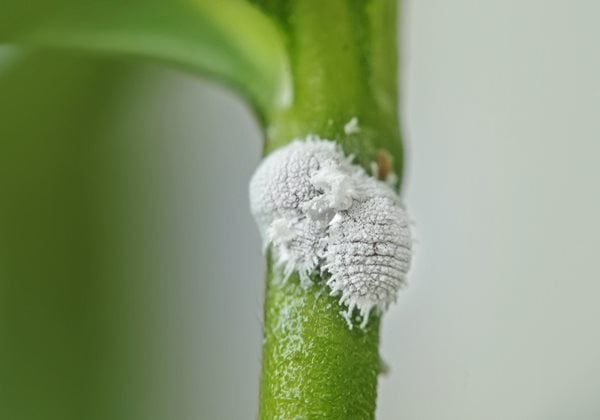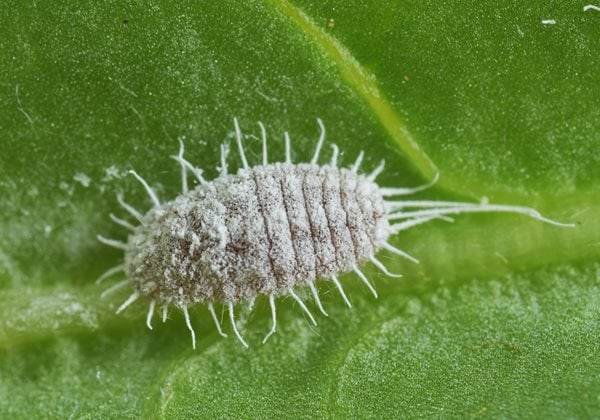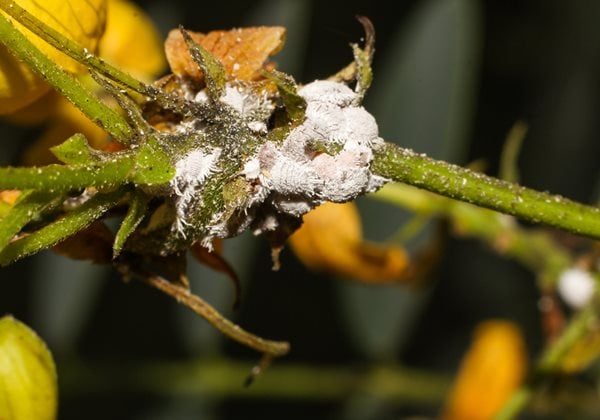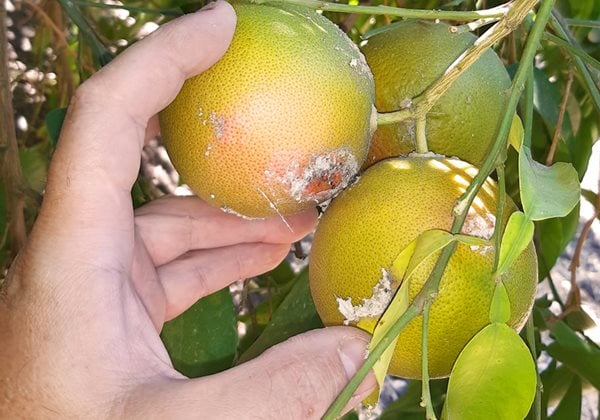How to Identify & Control Mealybugs
Keep your plants safe from this indoor and outdoor pest
Photo by: OHishiapply / Shutterstock
A common garden pest, mealybugs can wreak havoc on indoor and outdoor plants if not kept in check. The damage they cause can look similar to that of other pests, so it’s important to properly identify the source before treating affected plants.
Mealybugs thrive in warmer temperatures and are most often found on houseplants, greenhouse-grown specimens, or outdoor landscape plants in warm climates. In colder regions, they can be present outdoors during warmer summer months.
Because mealybugs reproduce frequently and in large numbers, it’s crucial to recognize the early signs in order to control and eradicate these pests.
On this page: What Are Mealybugs? | Types of Mealybugs | Get Rid of Mealybugs | Prevent Mealybugs | Recognize the Presence of Mealybugs | Identify Damage | Plants Susceptible | Frequently Asked Questions
On this page:
- WHAT ARE MEALYBUGS?
- TYPES OF MEALYBUGS
- HOW TO GET RID OF MEALYBUGS ON PLANTS
- HOW TO PREVENT MEALYBUGS
- RECOGNIZE THE PRESENCE OF MEALYBUGS
- IDENTIFY MEALYBUG DAMAGE ON PLANTS
- PLANTS SUSCEPTIBLE TO MEALYBUGS
- MEALYBUGS ON HOUSEPLANTS
WHAT ARE MEALYBUGS?
Mealybugs are small soft-bodied insects that are 1/20 to 1/5 inch in size. The white or pale pink body is oval and distinctly segmented, with a white or gray cottony wax coating. Mealybugs are related to scale; however, unlike scale, they retain their legs throughout their life cycle. Mealybugs crawl and move slowly, so will not rapidly disperse on their own.
Adult females are wingless, while adult males, which are seldom seen, are wasp-like in appearance and are winged and flying. Mealybugs reproduce quickly and in large numbers, making them difficult to control and eradicate.
Mealybugs have sucking mouthparts that are used to extract sap from plants. As they feed, some species may inject toxins or plant pathogens into host plants. Mealybugs excrete a sticky substance called honeydew, which can cause secondary problems, such as sooty mold or attracting ants.
TYPES OF MEALYBUGS

Long-tailed mealybug. Photo by: AjayTVM / Shutterstock.
There are hundreds of mealybug species, with about 300 species found in North America. Some of the more common include:
Citrus mealybugs attack citrus, landscape shrubs, and tropical or greenhouse specimens such as begonia, coleus, amaryllis, and cyclamen.
Long-tailed mealybugs are named for the tail filaments that develop on this species. They prefer citrus, grapes, nursery stock, houseplants including dracaena, and can also affect a wide range of ornamental plants.
Grape mealybugs target grape vines and fruit trees such as pears and pomegranates.
Mexican mealybugs prefer to feed on ornamental plants including chrysanthemum, English ivy, lantana, geranium, hollyhock, and poinsettia.
Root mealybugs feed on the roots of ornamentals including anemone, iris, yarrow, African violet, and many types of shrubs and ornamental grasses.
HOW TO GET RID OF MEALYBUGS ON PLANTS
Their outer wax coating acts as a shield, making it difficult to eradicate mealybugs with soap or oils. These remedies are more effective on young nymphs, which have less protection.
If mealybugs are present, try these tips:
Spray with water:
For lighter infestations, mealybug adults, nymphs and eggs can be dislodged with a gentle spray of water. Take care not to spray too hard to avoid damage to plant tissues.Keep leaves clean:
To control honeydew and sooty mold, wipe down affected leaves with a damp cloth or spray with water.
Introduce natural predators:
For outdoor and greenhouse environments, beneficial insects that prey on mealybugs offer natural pest control. These include lacewings, spiders, ladybugs, parasitic wasps, minute pirate bugs, and a lady beetle known as a mealybug destroyer.
Use rubbing alcohol:
Use a solution of 70% isopropyl alcohol. Soak a cotton ball in the alcohol and dab affected areas, which will remove and kill insects. Test a small area first to make sure it doesn’t cause leaf burn. For larger infestations, a 10-25% solution diluted with water can be applied with a spray bottle. Repeat weekly if necessary.
Prune:
If the infestation is localized, trim out affected branches and dispose in the garbage.
Use insecticidal soap:
For heavier indoor or outdoor infestations, use an insecticidal soap, such as Safer's. You can also make your own solution by mixing 1 tablespoon of mild liquid soap such as Castile or Ivory with 1 quart of water. Apply with a spray bottle. Repeat treatment if necessary.
Try horticultural oil:
Neem oil is a natural remedy derived from the neem tree. The oil will coat and suffocate eggs, nymphs and adults. Repeat treatment as needed. (Read more on how to use neem oil.)
Dispose of affected plants:
Sometimes infestations are too big or can’t be controlled even with repeat applications of soap, oil, or other remedies. In this case, the best solution may be to throw out the entire plant to prevent the spread of mealybugs to other plants.
Avoid chemical insecticides:
Though they may control mealybug infestations, they may also kill beneficial insects.
HOW TO PREVENT MEALYBUGS
The most effective tool for controlling mealybugs is prevention.
Keep plants healthy:
Healthy plants are more able to ward off pests and diseases.
Plant selection:
Choose plants that are less prone to mealybugs.
Inspect new plants:
Carefully inspect newly purchased plants before bringing them home from the nursery to prevent spreading pests to other plants.
Check plants regularly:
Make it part of your plant maintenance routine to inspect plants regularly to detect problems early on. Pay closer attention to plants that are more susceptible.
Know the signs:
Look for insects or eggs on new growth and more hidden areas. Check for plant damage, honeydew, or black sooty mold.
Apply horticultural oil regularly:
For susceptible plants, wipe down leaves periodically with Neem oil to discourage pests.
Avoid nitrogen-rich fertilizer and overwatering:
Nitrogen stimulates tender new growth that mealybugs prefer, and may lead to increased egg production. Too much water can also lead to excessive new growth.
Check tools, pots, and stakes:
Mealybugs and eggs sacs may be hidden in these spots.
Lower indoor temperatures:
Mealybugs thrive in temperatures between 70 to 90 degrees F. For houseplants that can tolerate cooler temperatures, lower the thermostat to 60 degrees F at night to discourage pests.
HOW TO RECOGNIZE THE PRESENCE OF MEALYBUGS

Photo by: TBamphoto / Shutterstock
Look for excretions:
Mealybugs are most often found in colonies. Observe plants for white cotton-like excretions, which will indicate clusters of mealybugs or their egg sacs. Mealybugs are sometimes confused with other pests that also produce waxy coatings such as scale, aphids, and whiteflies. Pull back the cottony coating and examine closely to properly identify.
Examine plants thoroughly:
Mealybugs prefer more hidden spots. Look in leaf/stem joints, between two touching fruits, on stems near the soil, or around the plant crown.
Check new growth:
These pests feed on newer plant growth, which is more tender.
Inspect containers:
Check around drainage holes of potted plants for cottony masses to detect the presence of root-feeding mealybugs.
Look for sooty mold:
The appearance of black sooty mold that develops from the presence of honeydew excretions is another indicator of mealybugs. Honeydew is produced by other sucking insects including whitefly, aphids, or leafhoppers, so it’s important to properly identify the source.
IDENTIFY MEALYBUGS DAMAGE ON PLANTS
Mealybugs feed by extracting sap from plants, causing damage to plant tissue. Symptoms may include stunting, yellow or wilted leaves, deformed growth, loss of flower buds, defoliation, and chlorosis. Honeydew excretions can interfere with photosynthesis and encourage a fungus called sooty mold. With extreme infestations, plants may die.
PLANTS SUSCEPTIBLE TO MEALYBUGS

Photo by: Protasov AN / Shutterstock.
Weakened or stressed plants are more prone to pest damage.
Houseplants that mealybugs prefer include African violets, begonias, dracaena, hoya, orchids, jade plant, palms, philodendron, schefflera, clivia, and poinsettia.
Succulents, such as aloe, agave, and echeveria, are more vulnerable because of their compact shape and multi-layered leaf structure. Mealybugs like to hide in plant crevices, so plant damage may not be apparent until an infestation is well underway. Affected plants may develop scarred leaves and become deformed.
Fruit trees and crops such as citrus, avocado, mango, and fig are more susceptible. Mealybug infestations may cause fruits to drop off prematurely.
Woody shrubs and ornamentals can be prone to mealybugs in warmer temperatures, causing flower buds to drop off prematurely. Kniphofia and phormium plants are especially susceptible.
Vegetable crops such as cabbage, cucumber, lettuce, asparagus, peppers, and beans may be affected.
FREQUENLY ASKED QUESTIONS
What causes mealybugs?
Mealybugs are most often introduced from infested greenhouse-grown plants purchased at a nursery or garden center. They may also be found in potting soil or on grocery store produce. Carefully inspect new plants before buying and isolate new houseplants for several weeks to make sure you’re not introducing pests to other plants.
Are mealybugs harmful to humans?
Mealybugs don’t bite, but coming into direct contact with them can cause mild skin irritation for some people.
Why do mealybugs appear?
Mealybugs are attracted to certain kinds of plants and those with young new growth. They thrive in warmer temperatures, so will be more commonly present outdoors during summer, in greenhouse environments, or inside the home.
RELATED:
Getting Rid of Japanese Beetles
How to Get Rid of Grub Worms
